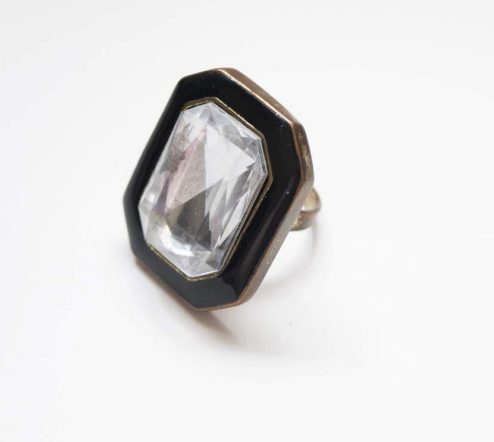
Fashion Flashback: Rings
Fashion Flashback: Rings by Morgan Watkins
Known as a symbol of love, rings are absolutely essential for any accessory lover’s arsenal. They’ve been around for thousands of years, featuring a plethora of various metals and precious stones while gracing the fingers of both royalty and everyday individuals alike. If you’ve ever wondered how this hand-tastic piece of jewelry came to fruition, keep on reading.
The oldest dated rings were discovered in ancient Egyptian tombs dating back as early as 2500 BC. Egyptians in particular greatly valued their accessories, as they were deeply attached to what each piece symbolized. Rings were used as talismans and amulets to ward off hostility and harm. Animals like snakes and scorpions were featured on rings, as they were creatures that evoked fear and protected the wearer. Even when met with death, Egyptians wore their rings and other accessories into the afterlife, hence why so many precious jewels have been discovered in tombs. It was around this time that the exchange of wedding rings was originated. Initially, Egyptians weaved hemp circles to create bands representing a link to immortal love. The fourth finger on your left hand has a vein that runs straight to the heart, which is why it is custom in most countries to wear your wedding ring on your left ring finger. Although women were often seen sporting rings commemorating their marriages long ago, men were rarely seen wearing wedding bands until WWI and WWII, where their rings served as a reminder of the love they had waiting for them back home.

(Image from http://www.grimballjewelers.com/chapel-hill-jewelry-blog/2016/6/9/the-long-history-of-en gagement-rings-and-wedding-rings)
Another symbol often associated with rings in particular is status and class. In early Rome, rings were first made from iron. Only noble individuals, like senators serving ambassadors of the Republic, could indulge in the privilege of wearing gold rings. And although the right to wear gold was eventually granted to all ancient Romans, only those with wealth and power could obtain such expensive goods. While royalty and nobles wore gold and silver adorned with precious jewels, poor commonfolk had to settle for pewter, bronze and copper.

(Image from https://www.peterszuhay.com/ads/ancient-roman-gold-ring-with-intaglio/)
The 16th and 17th centuries saw massive growth in the world of goldsmithing. Bands had become more intricately sculpted as art from the Renaissance era poured in, inspiring unique and fresh innovations. One ring in particular that was designed to be both utilitarian and beautiful was the hinged ring, which could be used to oh-so discreetly carry anything from intoxicating fragrances to deadly poisons. Rubies, emeralds and sapphire came into style as well, arranged in a gaggle of new shapes, sizes and cuts. But this era was not all colorful stones and fun bands. Plagues and deadly diseases served as constant reminders of impending and inescapable mortality, which led to the creation of rings inscribed with skulls, skeletons and caskets. These became known as memento mori rings, and would become a staple of the late 17th century.

(Image from https://talkingfashion.net/products/copy-of-floral-carved-cocktail-ring-vintage-plastic-jew elry)
After the 17th century ended on a low note, the 18th century brought with it a new breath of life in the world of rings. Styles were refined, bands became more delicate and brightly colored gems and stones were arranged in creative new ways, like floral bouquets and ribbons tied into bows. Bezel shapes were elongated and reimagined, leading to the birth of shapes like oval, navette, lozenge and octagonal.

(Image from http://charlottesayers.co.uk/items/18th-century-amethyst-and-diamond-basket-ring/)
The 19th and 20th centuries were also a fantastic representation of creativity in ring design. The diamond solitaire ring became a fan favorite style, as did birthstone engagement rings. These were popularized by none other than Queen Victoria, who wore her May birthstone, an emerald, on her ring finger. By the early to mid 20th century, art deco influenced stimulating and fresh designs. Fun geometric shapes adorned the fingers of those far and wide, serving as a bit of a distraction from the ever so somber Great Depression. Rings were made with cheaper materials but still served as a stylish and easy way for fashion fanatics to accessorize on a tight budget.

(Image from https://talkingfashion.net/products/copy-of-pink-purple-cocktail-ring-sparkling-crystal-rhin estones-adjustable-band-statement-bling-jewelry)
Presently, rings come in all shapes, materials and sizes and can be worn in a myriad of ways. Thankfully, you don’t have to be a Roman ruler to rock a set of sparkling gold rings these days.

(Image from https://talkingfashion.net/products/copy-of-green-jewel-ring-adjustable-bijoux-contempocostume-jewelry)
Bibliography “19th Century Engagement Rings & Trends.” Victor Barbone Jewelry. Victor Barbone Jewelry, 2017. Web.
Amelio-Ortiz, Cuini. “The History of the Ring– the Gold Rings of Ancient Egypt.” World of Gemstones. Rocks & Co, Web.
Cassell, Amy. “History of the Wedding Ring.” Destination Weddings & Honeymoons. Bonnier Corporation, 2012. Web.
“Rings: Ancient to Neoclassical.” Antique Jewelry University. Lang Antique & Estate Jewelry, Web.
